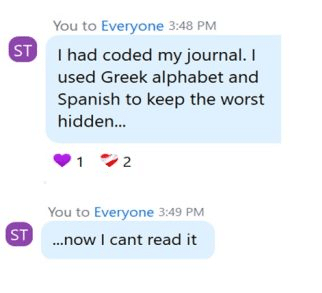I was cautious, but hopeful, about attending a professional seminar by Erena DiGonis for clinical counselors about clinical journaling in general, and in pursuit of one particular approach: Pennebaker’s storytelling method.
I picked up more, so much more than I expected. Getting informed this way is safer than just charging into Pennebaker’s method—or anybody’s method. Moreover, this education and experience made me better at evaluating therapists for myself.

How I “Met” Trauma Journaling via Pennebaker’s Method
A friend who had known Pennebaker at college asked me to try the Pennebaker method. He’s using it to see if it would move his complex trauma. He sent a link about the Pennebaker method from podcaster Alex Huberman. After listening to it a couple of times, my friend and I penciled out the steps for trying it out. We began an eight-week test, writing at least one story weekly about a childhood trauma.
I suspended my effort five weeks in. I was struggling with what was coming up for me.
We had the steps, essentially, but what we didn’t have were the prerequisites. Both of us come from science/tech education backgrounds, and we regard protocols seriously. We didn’t expect results if we didn’t follow the defined protocol. Our combined notes laid out the steps, but not the safeguards. And I did not exercise my choice about engagement until I had to quit Pennebaker’s method outright. Making the choice of breaking the protocol I was testing…didn’t make sense to me. But neither did hurting myself.
We continue to work on this privately. That said, I completely understand and agree with one of the key learnings I took from Erena DiGonis’s class: Pennebaker is not the method I should try first if I want to intentionally journal for trauma, especially if not supported by professional help. There are easier starts, and alternative approaches, and Huberman’s podcast ends with a fine list of resources for more information.
Seven Sentence-long Summaries and Safeguards
These are not just about Pennebaker; he is one of many. Journaling assumptions may not work if a client with a stroke suddenly finds she can’t spell or write any longer, but can read. So, the first rule emerges:
1. Spelling and grammar/don’t matter.
If you are not a good reader, writer, college graduate, or a verbal personality, you can still benefit from journaling. Writing lyrics worked for people whose gifts aren’t academic. Lyrics are accessible; they have a beat. “Many of our clients are creatives that are suppressed,” said one attendee. “They may well be coming for help with that.” Think of quote journals, the scrapbook approach, “memebooks,” haiku, poembook collections of your favorites, and deliberate musical choices to listen to, feel, or write.
2. Complex cases may not be appropriate for clinical journaling. (Consider the Kate Adams Journal Ladder instead.)
I can speak to this one personally: it’s like the Robert Frost poem “The Road Not Taken,” or spring cleaning your house after 20 years of neglect; there’s always more stuff, more associations…more stories. That is one of the shocking things about Pennebaker’s effect on me: I found deep relationships among trauma stories I thought were disconnected. I have since realized just how much danger I was in when I was surviving the events that came up. This has been retraumatizing. I would have started there first, knowing what I know now.
3. Keep it to yourself.
Adults have profound and justified fears about having a journal’s privacy violated. I posted my efforts to protect my journal at college.

Horrifying stories emerged from attendees. Erena said, “Privacy violations compound the trauma.” The journal has only one reader, and that’s the author. Clinicians follow up on whether the homework is done, as a safeguard.
4. “You need to shift from judge to scientist.”
Being very purpose-focused, intent on the journal as data, helps. Don’t just rehearse the trauma by witnessing it again.
5. Affirmations, IF-firmations, and Gratitude: Attitude guides discovery.
We briefly discussed the Smyth study: Positive Affect Journaling and related approaches.
“Affirmations” don’t mean anything to me. I just think I’m lying to myself. I’ve used “IF-firmations”—“What if ?” The “IF” opens possibility in a way that the uncritical affirmation doesn’t.
Gratitude comes when you have enough time to see what the terrible experience left as a gift. “Trauma works like an initiation,” said Janelle Innerarity, a counselor in private practice. “It cleans you out, but it leaves debris.”
You can’t be expected to be grateful that bad things happened to you if you never found the benefit. Gratitude comes with time and distance; it has its own geometry. It has made sense to me to pair trauma journaling with the gratitude journal and measure the gap between the hurting and the healing.
6. “Put it on the prescription pad. There’s an insurance code for that.”
Dollar Store supplies work fine: cheap notebooks, colored pens, stickers…I often journal with photographs and found items. Talk with your therapist (if you have one) about what they can cover.
7. Journal with media you like.
Visual and audio journaling also work. Just capture the story in the medium that’s easiest for you. Mind maps work too, scattering words on a page and making connections that feel right; there’s a free online tool from Lucid if you like digital tools.
Guest Post Disclaimer: Any and all information shared in this guest blog post is intended for educational and informational purposes only. Nothing in this blog post, nor any content on CPTSDfoundation.org, is a supplement for or supersedes the relationship and direction of your medical or mental health providers. Thoughts, ideas, or opinions expressed by the writer of this guest blog post do not necessarily reflect those of CPTSD Foundation. For more information, see our Privacy Policy and Full Disclaimer.





I’m truly honored to be acknowledged in this blog. Thank you very much! ⭐️